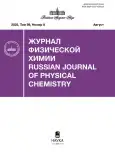Setting the oxidation state of 99Tc adsorbed on Pt, by X-ray photoelectron spectroscopy
- Autores: Veselov S.V.1,2, Teterin A.Y.3, Maslakov K.I.3,4, Teterin Y.A.3,4, Kuznetsov V.V.1,2, German K.E.1
-
Afiliações:
- Frumkin Institute of Physical Chemistry and Electrochemistry, Russian Academy of Sciences
- FGBOU VO “D. I. Mendeleev Russian University of Chemical Technology”
- SIC “Kurchatov Institute”
- Lomonosov Moscow State University
- Edição: Volume 99, Nº 8 (2025)
- Páginas: 1238-1247
- Seção: PHYSICAL CHEMISTRY OF DISPERSED SYSTEMS AND SURFACE PHENOMENA
- ##submission.dateSubmitted##: 06.11.2025
- ##submission.datePublished##: 15.08.2025
- URL: https://journals.eco-vector.com/0044-4537/article/view/695898
- DOI: https://doi.org/10.7868/S3034553725080162
- ID: 695898
Citar
Texto integral
Resumo
Sobre autores
S. Veselov
Frumkin Institute of Physical Chemistry and Electrochemistry, Russian Academy of Sciences; FGBOU VO “D. I. Mendeleev Russian University of Chemical Technology”Moscow, Russia; Moscow, Russia
A. Teterin
SIC “Kurchatov Institute”
Email: antonxray@yandex.ru
Moscow, Russia
K. Maslakov
SIC “Kurchatov Institute”; Lomonosov Moscow State UniversityMoscow, Russia; Moscow, Russia
Yu. Teterin
SIC “Kurchatov Institute”; Lomonosov Moscow State UniversityMoscow, Russia; Moscow, Russia
V. Kuznetsov
Frumkin Institute of Physical Chemistry and Electrochemistry, Russian Academy of Sciences; FGBOU VO “D. I. Mendeleev Russian University of Chemical Technology”Moscow, Russia; Moscow, Russia
K. German
Frumkin Institute of Physical Chemistry and Electrochemistry, Russian Academy of SciencesМосква, Россия
Bibliografia
- Chakravarty R., Venkatesh M., Dash A. // J. Radioanal. Nucl. Chem. Art. 2011. V. 290. № 1. P. 45. https://doi.org/10.1007/s10967-011-1113-z
- Hendee W.R., Ritenour E.R. Medical imaging physics. John Wiley & Sons, 2003. 536 p.
- Mengesha W.G. // Am.J. Mod. Phys. 2024. V. 13. № 2. P. 27. https://doi.org/10.11648/j.ajmp.20241302.13
- Vaz S.C., Oliveira R., Herrmann K., Veit-Haibach P. //The British journal of radiology. 2020. V. 93. № 1110. P. 20200095. https://doi.org/10.1259/bjr.20200095
- Duatti A. // Nucl. Med. Biol. 2021. V. 92. P. 202. https://doi.org/10.1016/j.nucmedbio.2020.05.005.
- Кодина Г.Е., Малышева А.О. // Ведомости Научного центра экспертизы средств медицинского применения. 2019. Т. 9. № 4. С. 216. https://doi.org/10.30895/1991-2919-2019-9-4-216-230
- Eckelman W.C. // J. Am. Coll. Cardiol. Img. 2009. V. 2. № 3. P. 364–8. https://doi.org/10.1016/j.jcmg.2008.12.013.
- Arano Y. // Ann. Nucl. Med. 2002. V.16. № 2. P. 79. https://doi.org/10.1007/BF02993710
- Abubakr A., Othman A.I., Ewedah T.M. // ERU Res. J. 2024. https://doi.org/10.2967/jnumed.112.110338
- Pillai M.R.A., Dash A., Knapp F.F.R. // J. of Nucl. Med. 2013. V. 54. № 2. P. 313. https://doi.org/10.2967/jnumed.112.110338
- Boschi A., Martini P., Pasquali M., Uccelli L. // Drug Dev. Ind. Pharm. 2017. V. 43. № 9. P. 1402. https://doi.org/10.1080/03639045.2017.1323911
- Hasan S., Prelas M.A. // SN Appl. Sci. 2020. V. 2. № 11. P. 1782. https://doi.org/10.1007/s42452-020-03524-1
- Chakravarty R., Dash A., Venkatesh M. // Nucl. Med. Biol. 2010. V. 37. № 1. P. 21. https://doi.org/10.1016/j.nucmedbio.2009.08.010
- Russell C.D. // The Int. J. of Appl. Radiat. Isotop. 1982. V. 33. № 10. P. 883.
- Kuznetsov V.V., Volkov M., German K. et all. // J. Electroanal. Chem. 2020. V. 869. P. 114090. https://doi.org/10.1016/j.jelechem.2020.114090
- Волков М.А., Кузнецов В.В., Жирухин Д.А., Герман К.Э. // Успехи в химии и химической технологии. 2018. С. 203.
- Chotkowski M., Czerwiński A. Technetium Coordinated by Inorganic Ligands in Aqueous and Nonaqueous Solutions. In: Electrochemistry of Technetium. Monographs in Electrochemistry. Springer. Cham. 2021. P. 31. https://doi.org/10.1007/978-3-030-62863-5_3
- Patra S., Chakraborty S., Chakravarty R. // Am J. Nucl. Med. Mol. Imag. 2024. V. 14. № 5. P. 282. https://doi.org/10.62347/XITW6701
- Kuznetsov V.V. Chotkowski M., Poineau F. et al. // J. Electroanal. Chem. 2021. V. 893. P. 115284. https://doi.org/10.1016/j.jelechem.2021.115284
- Gurbanova U.M. Babanly D.M., Huseynova R.G., Tagiyev D.B. // J. Electrochem. Sci. Eng. 2021. V. 11. № 1. P. 39–49. https://doi.org/10.5599/jese.912
- Chotkowski M., Grdeń M., Wrzosek B. // J. Electroanal. Chem. 2018. V. 829. P. 148. https://doi.org/10.1016/j.jelechem.2018.10.003
- Kuznetsov V.V. German K.E., Nagovitsyna O.A. et al. // Inorg. Chem. 2023. V. 62. № 45. P. 18660. https://doi.org/10.1021/acs.inorgchem.3c03001
- Engelmann M.D., Metz L.A., Delmor J.E. et al. // J. Radioanal. Nucl. Chem. 2008. V. 276. P. 493. https://doi.org/10.1007/s10967-008-0532-y
- Chatterjee S., Hall G.B., Johnson I.E. et al. // Inorg. Chem. Front. 2018. V. 5. № 9. P. 2081.
- https://doi.org/10.1039/C8QI00219C
- Makarov A., Safonov A., Sitanskaia A., Martynov K. et al. // Prog. In Nucl. Energy. 2022. V. 152. Р. 104398. https://doi.org/10.1016/j.pnucene.2022.104398.
- Данилов С.С., Фролова А.В., Тетерин А.Ю. и др. // Радиохимия. 2021. Т. 63. № 6. С. 582. https://doi.org/10.31857/S0033831121060101.
- Герасимов В.Н., Крючков С.В., Кузина А.Ф. и др. // Докл. АН СССР. 1982. Т. 266. C. 148.
- Wester D.W., White D.H., Miller F.W. et all. // Inorg. Chim. Acta. 1987. V. 131. № 2. P. 163. https://doi.org/10.1016/s0020-1693(00)96019-5.
- Thompson M., Nunn A.D., Treher E.N. // Anal. Chem. 1986. V. 58. P. 3100. https://doi.org/10.1021/AC00127A041.
- Shirley D.A. // Phys. Rev. B. 1972. V. 5. P. 4709. https://doi.org/10.1103/PhysRevB.5.4709.
- Панов А.П. Пакет программ обработки спектров SPRO и язык программирования SL. Препринт. М.: Ин-т атом. Энергии. ИАЭ-6019/15, 1997. 31 c.
- Немошкаленко В.В., Алешин В.Г. Электронная спектроскопия кристаллов. Киев: Наукова думка, 1976. 336 с.
- Band I.M., Kharitonov Yu.I., Trzhaskovskaya M.B. // At. Data Nucl. Data Tables. 1979. V. 23. P. 443. https://doi.org/10.1016/0092-640X(79)90027-5.
- Герасимов В.Н., Крючков С.В., Герман К.Э. и др. Рентгеноэлектронное исследование строения комплексных соединений технеция: Препринт. М.: Ин-т атом. Энергии. ИАЭ-5041/9. 1990. 32 с.
- Makarov A.V., Safonov A.V., Konevnik Yu.V. et al. // J. of Hazard. Mat. 2021. V. 401. P. 123436. https://doi.org/10.1016/j.jhazmat.2020.123436.
- Нефедов В.И. Рентгеноэлектронная спектроскопия химических соединений. Справочник. М.: Химия, 1984. 256 с.
- Sosulnikov M.I., Teterin Yu.A. // J. of Electr. Spectr. and Rel. Phen. 1992. V. 59. P. 111. https://doi.org/10.1016/0368-2048(92)85002-O.
- Childs B.C., Braband H., Lawler K. et al. // Inorg. Chem. 2016. V. 55. № 20. P. 10445. https://doi.org/10.1021/acs.inorgchem.6b01683.
- Rodriguez E.E., Poineau F., Llobet A. et al. // J. Am. Chem. Soc. 2007. V. 129. P. 10244. https://doi.org/10.1021/ja0727363.
Arquivos suplementares










